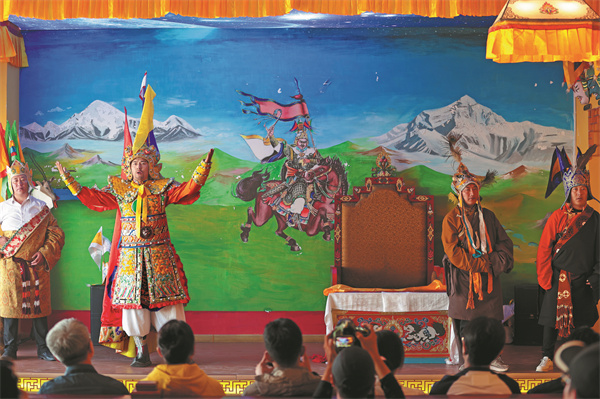Epic tale remains a story worth telling
Legendary king's exploits continue to resonate across the highlands in western and northern China, Deng Zhangyu reports.
By Deng Zhangyu | China Daily | Updated: 2025-03-29 08:44

Reaching out
Storytellers like Sithar Dorje are rare, most of them are just part-time performers — they tend to their herds during the day and perform the epic in their free time, says Wancheng Tsering, who has kept a close eye on these storytellers over the past 18 years.
He visited hundreds of singers across the country and compiled their individual stories into a book, which records 303 inheritors of the Gesar epic and was published in February.
"When my book was published, one-fifth of those storytellers recorded had passed away," says the 44-year-old, who works at the Gesar Research Center of Qinghai province.
Wancheng Tsering grew up in a village in the Hainan Tibetan autonomous prefecture in Qinghai. As a child, he frequently heard his grandfather recount tales of King Gesar.
"Almost everyone living in the area knows the story of the legendary hero. Whenever there is a wedding or a major festive event, storytellers and singers are invited to perform for us," he says.
He notices that apart from singing and narrating the stories of Gesar, more innovative forms have emerged in recent years. The hero's image and story have been immortalized in sculptures, thangka (a traditional Tibetan Buddhist painting on embroidered silk), murals, woodcuts, embroidery, dances, plays, Tibetan opera, and even films and animations.
"Many places integrated the Gesar culture with tourism. People can visit Gesarthemed museums and parks, watch shows in theaters and buy related embroidery products," he says.
Three protection zones for King Gesar culture have been set up in the Golog and Yushu Tibetan autonomous prefectures in Qinghai, and Nagchu in Xizang, where most storytellers live.
Wancheng Tsering found that at least 30 Tibetan opera troupes perform classic excerpts from the Gesar epic in Golog, such as the king's unexpected victory at a horse race at the age of 13, whereby he becomes a respected and impressive hero, and eventually the legendary king.
Young storytellers in their 20s also use the internet to share their performances, he says. They livestream on short-video platforms like Douyin, the Chinese version of TikTok, and collaborate with other storytellers to perform together.
"These new forms are good for the dissemination of Gesar culture in contemporary times, allowing this ancient story to continue incorporating elements of the younger generation's narratives in the new era," says Wancheng Tsering.
Daqiong contributed to this story.
























